Theoretical Foundations to the Impact of Dog-Related Activities on Human Hedonic Well-Being, Life Satisfaction and Eudaimonic Well-Being
Abstract
:1. Introduction
2. Materials and Methods
2.1. Ethical Approval
2.2. Questionnaire Design and Structure
2.3. Measurements
2.3.1. Dog-Related Activities/Situations
2.3.2. Life Satisfaction and Hedonic Well-Being
2.3.3. Eudaimonic Well-Being
2.3.4. Closeness to the Dog
2.4. Participants
2.5. Statistical Analysis
3. Results
3.1. Demographics
3.2. Overview of the Reported Impact of Dog-Related Activities on Well-Being
3.3. Relationship between Closeness to the Dog and Reported Well-Being Outcomes
3.4. Effect of Dog-Related Activities on Specific Well-Being Outcomes
3.4.1. Positive Affect of High Arousal (e.g., Happiness, Excitement, Joy)
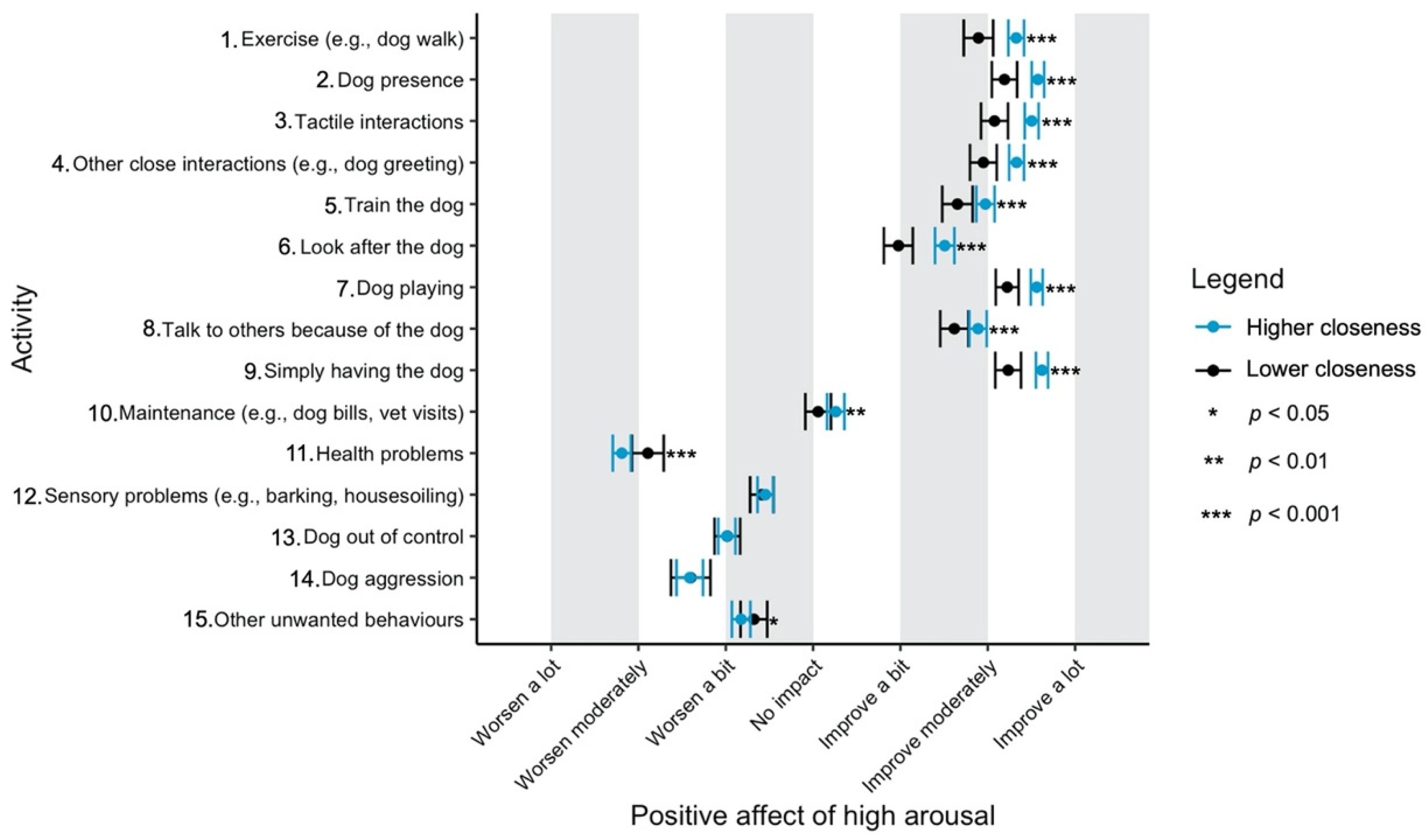
3.4.2. Positive Affect of Low Arousal (e.g., Calmness, Relaxation, Peacefulness)
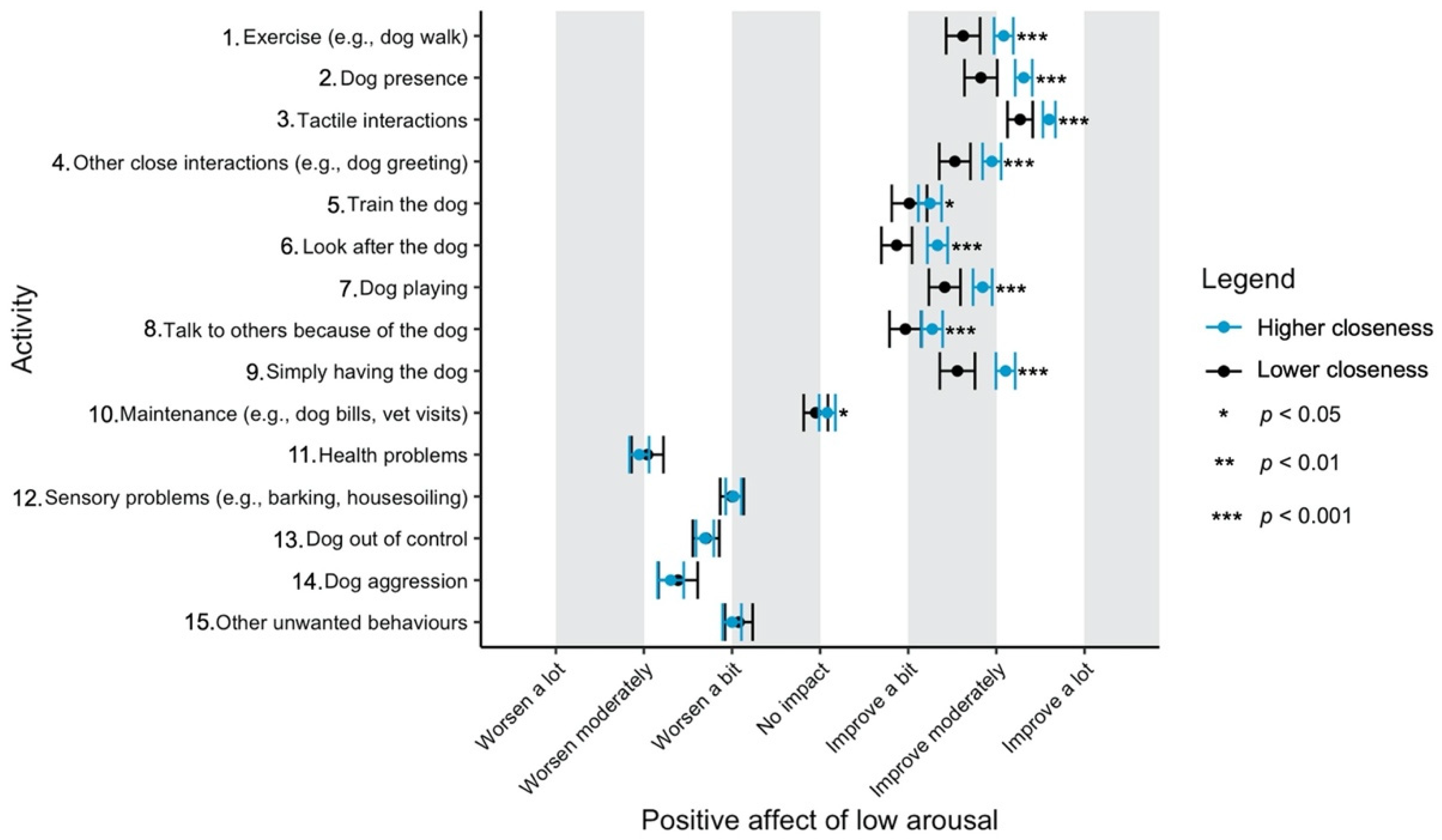
3.4.3. Negative Affect of High Arousal (e.g., Stress, Anger, Frustration)
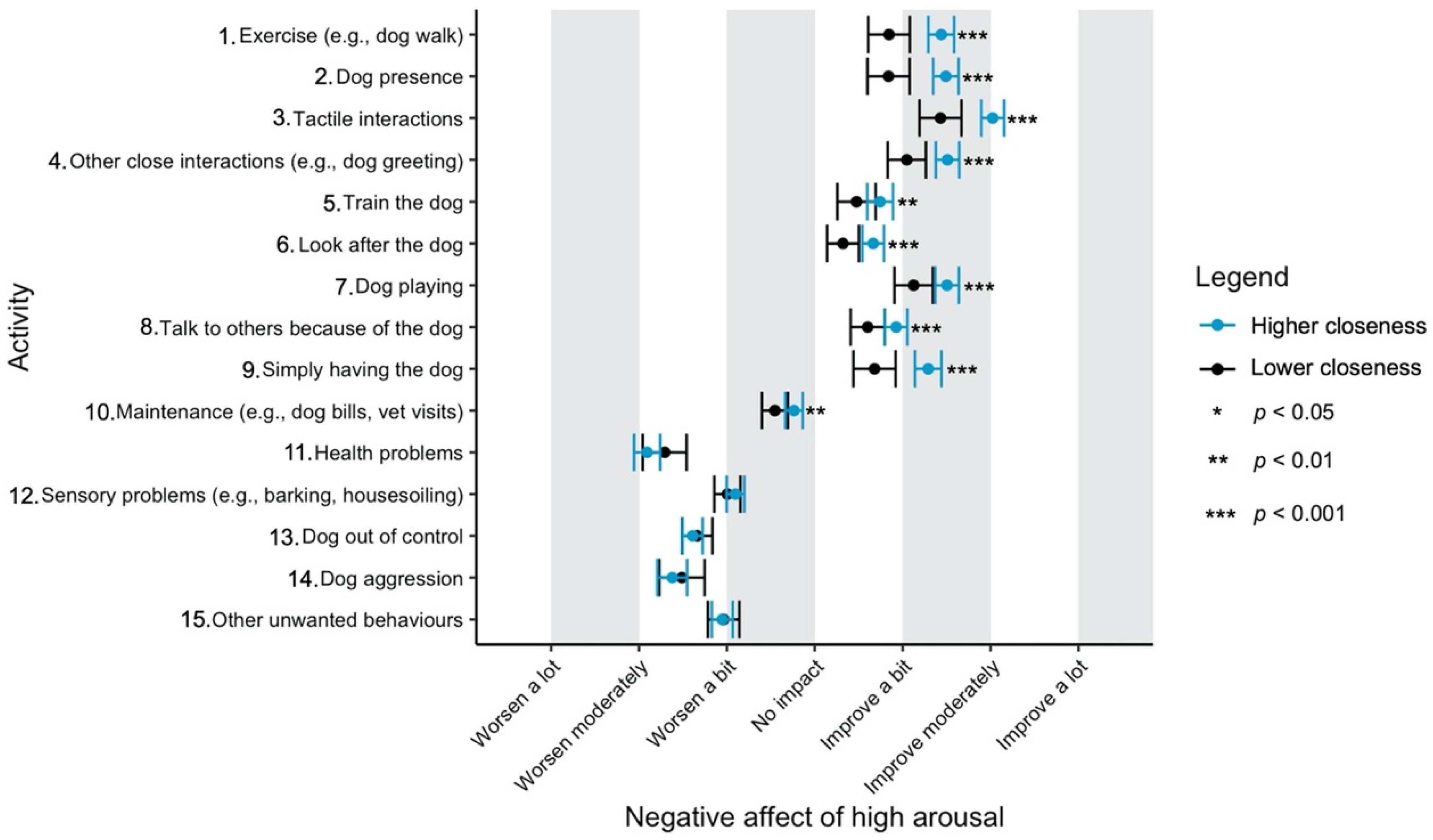
3.4.4. Negative Affect of Low Arousal (e.g., Sadness, Feeling Low, Frustration)
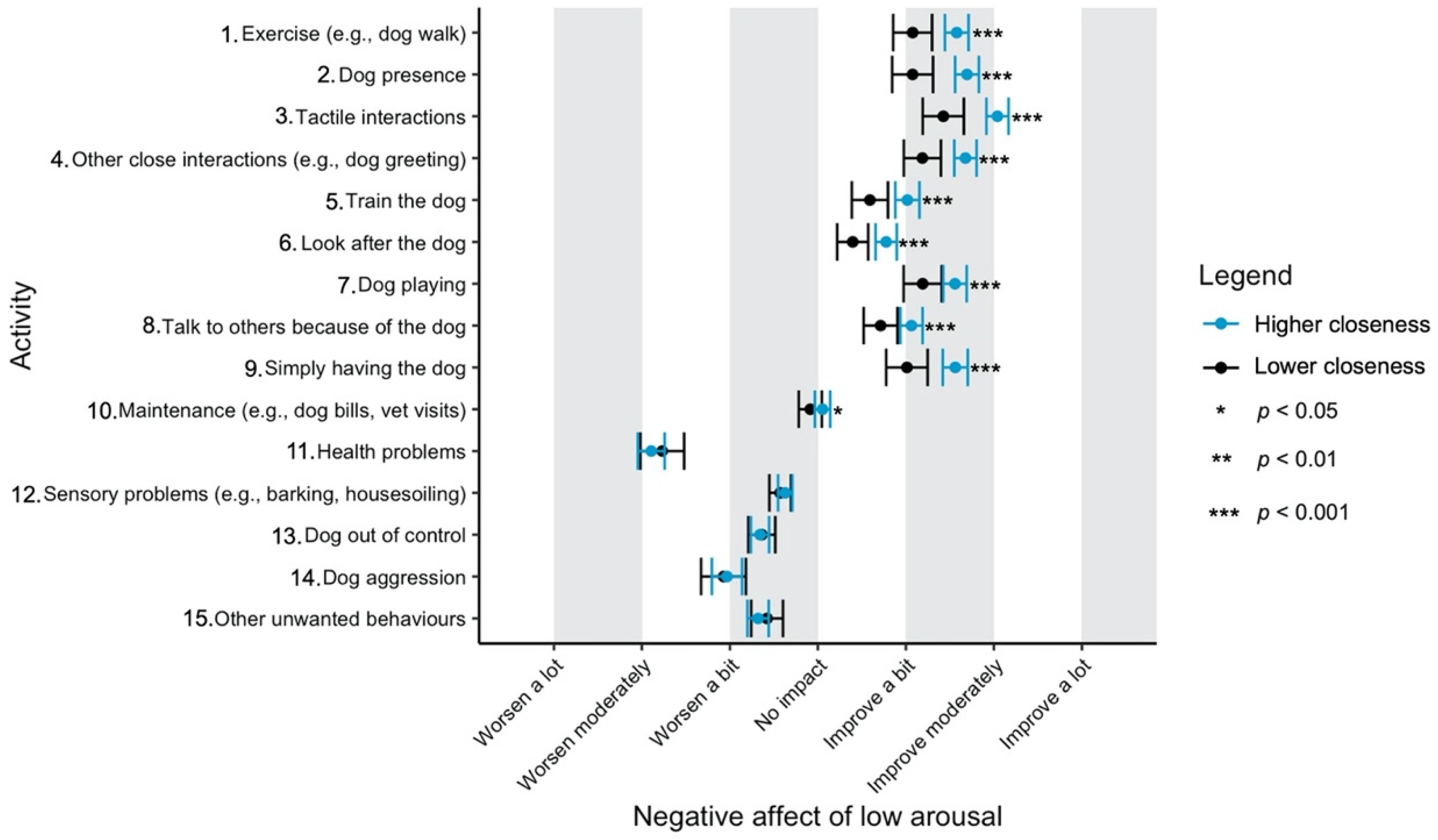
3.4.5. Life Satisfaction
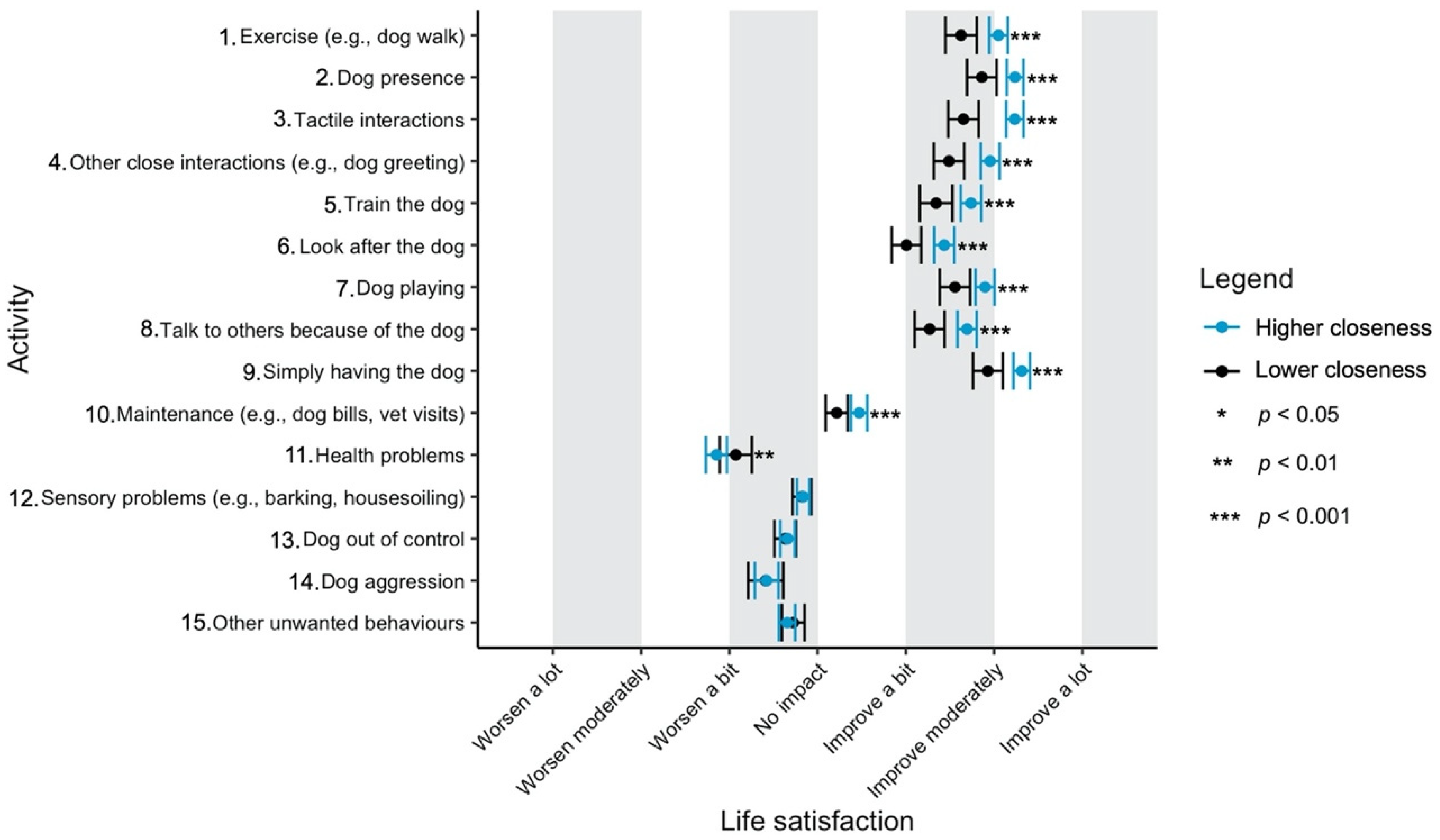
3.4.6. Autonomy
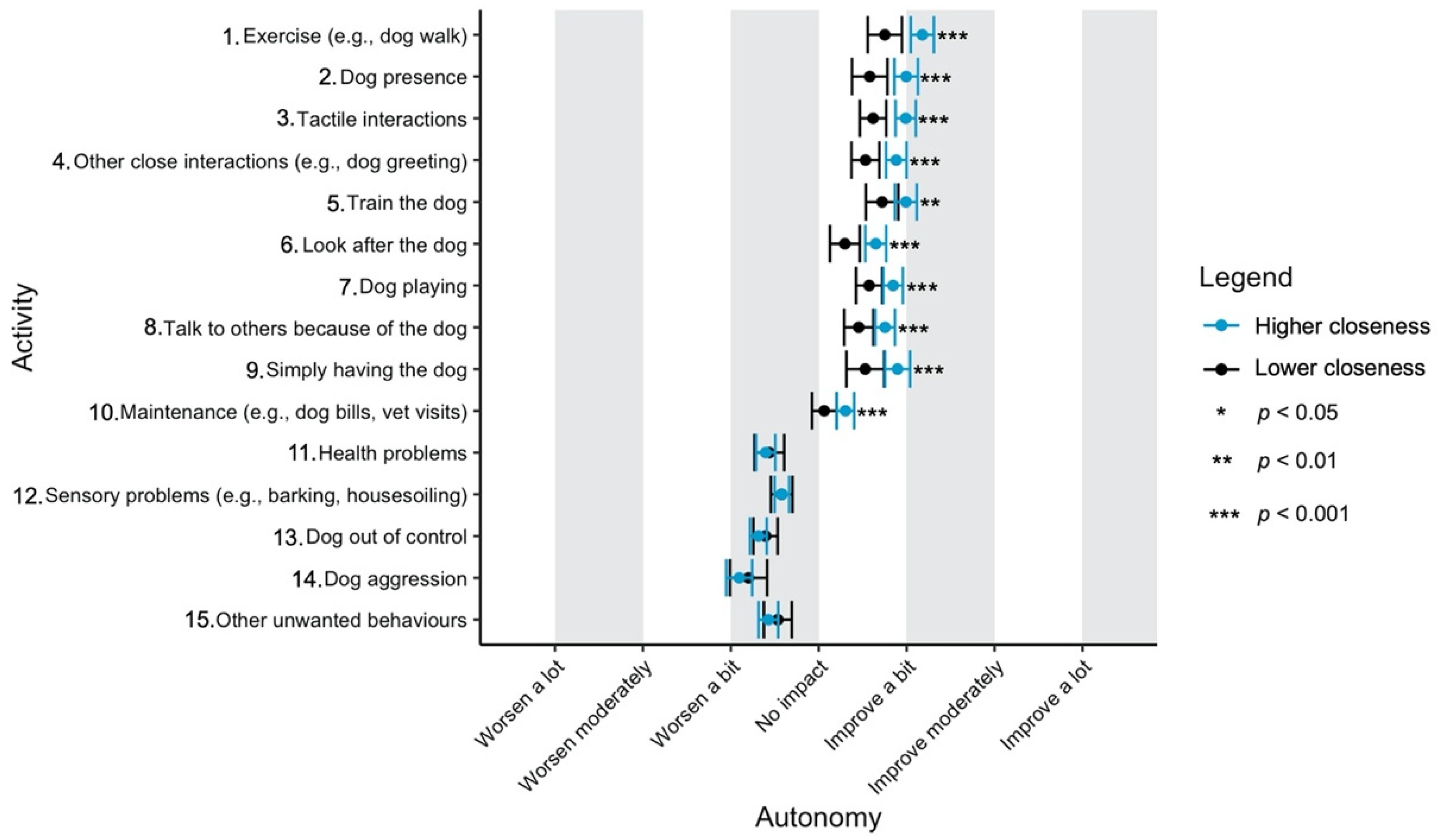
3.4.7. Environmental Mastery
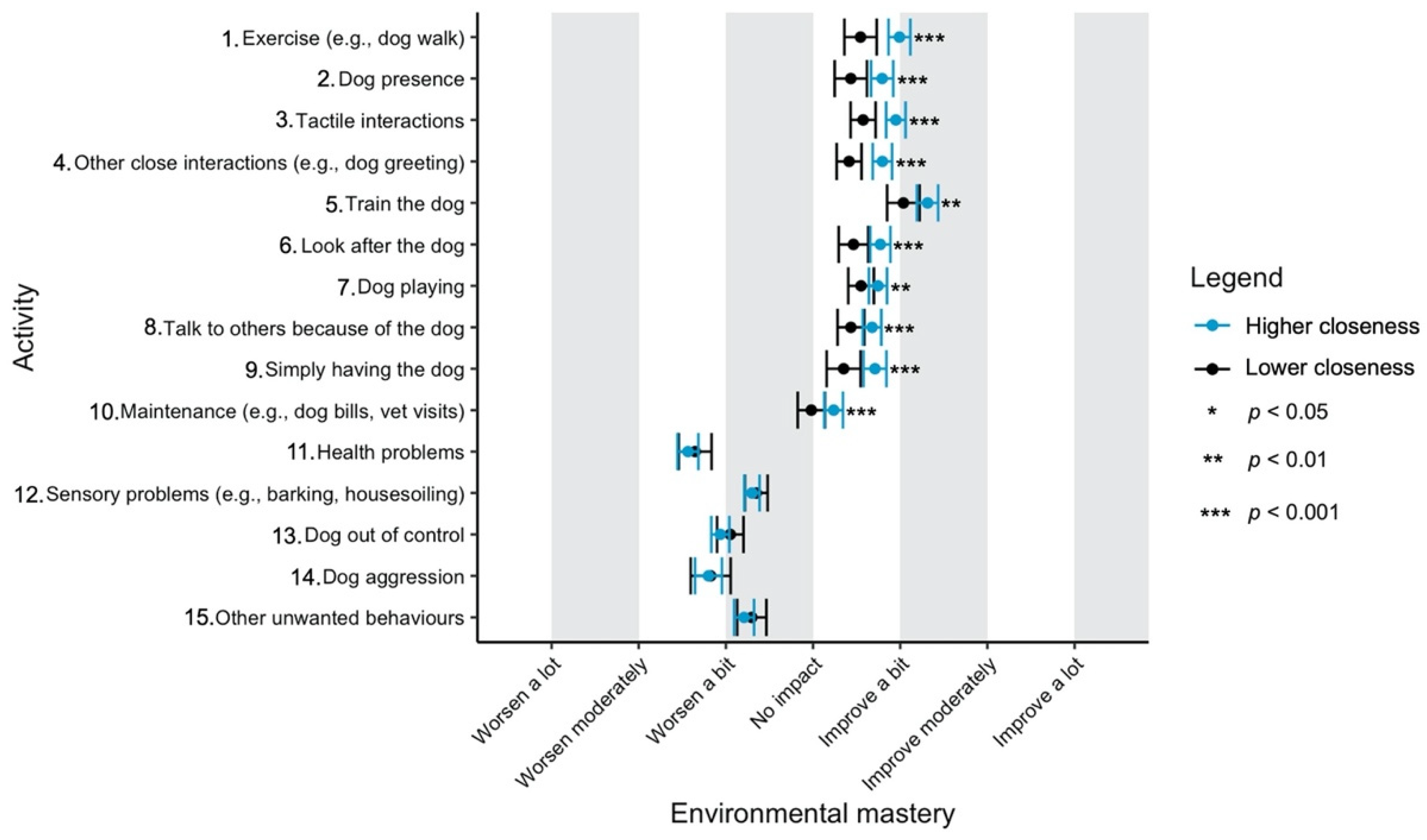
3.4.8. Personal Growth
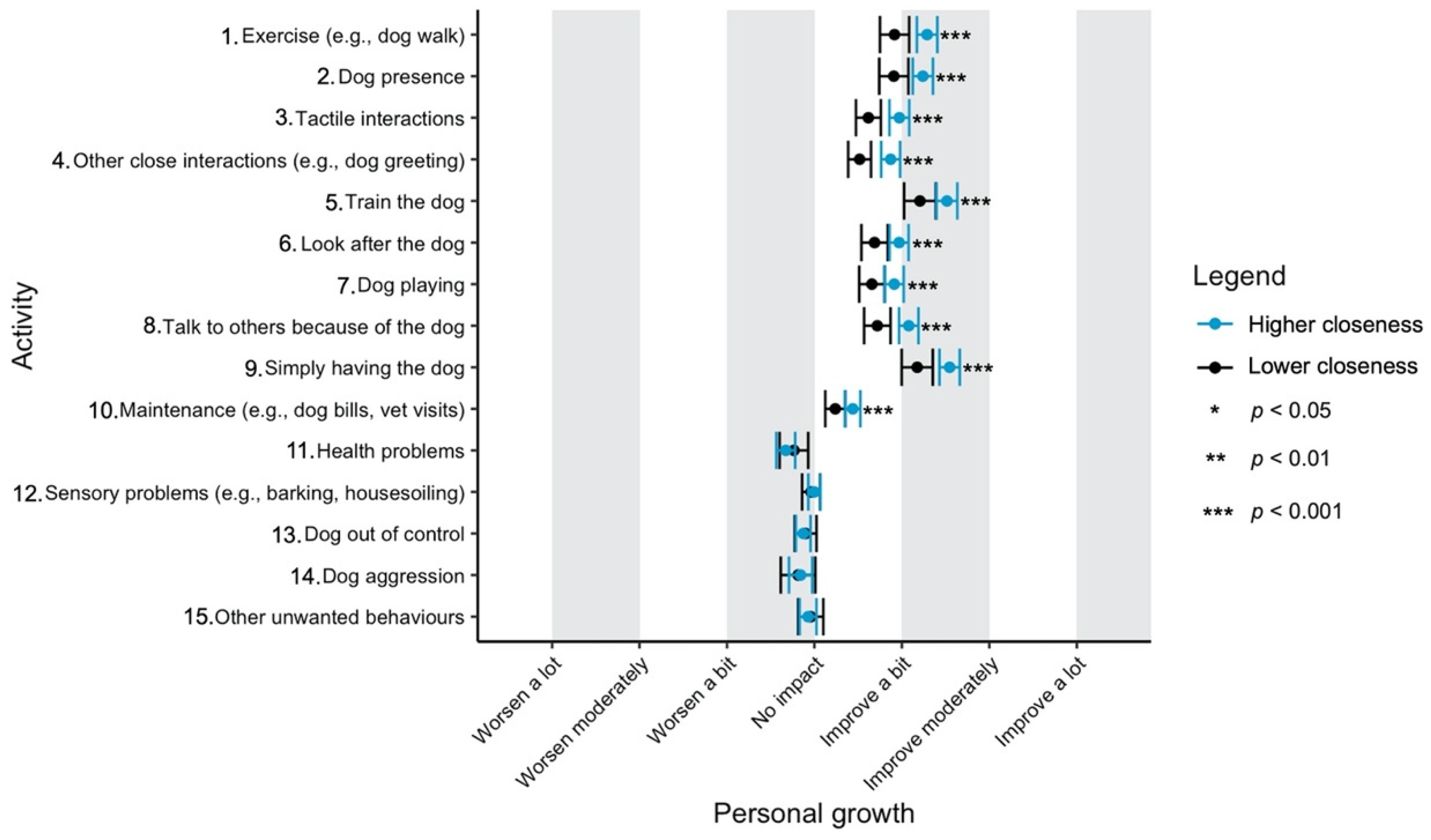
3.4.9. Positive Relations with Others
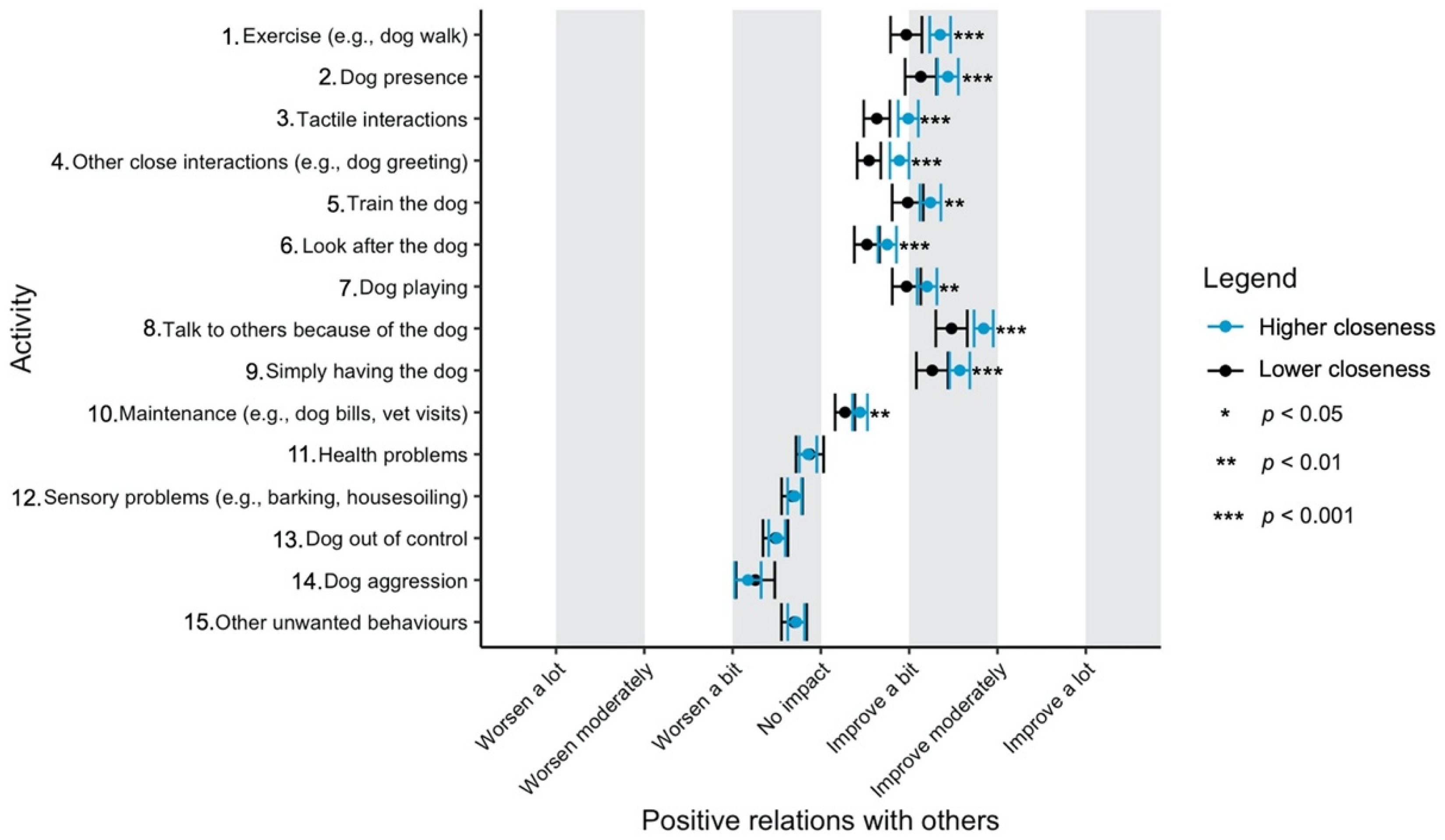
3.4.10. Purpose in Life
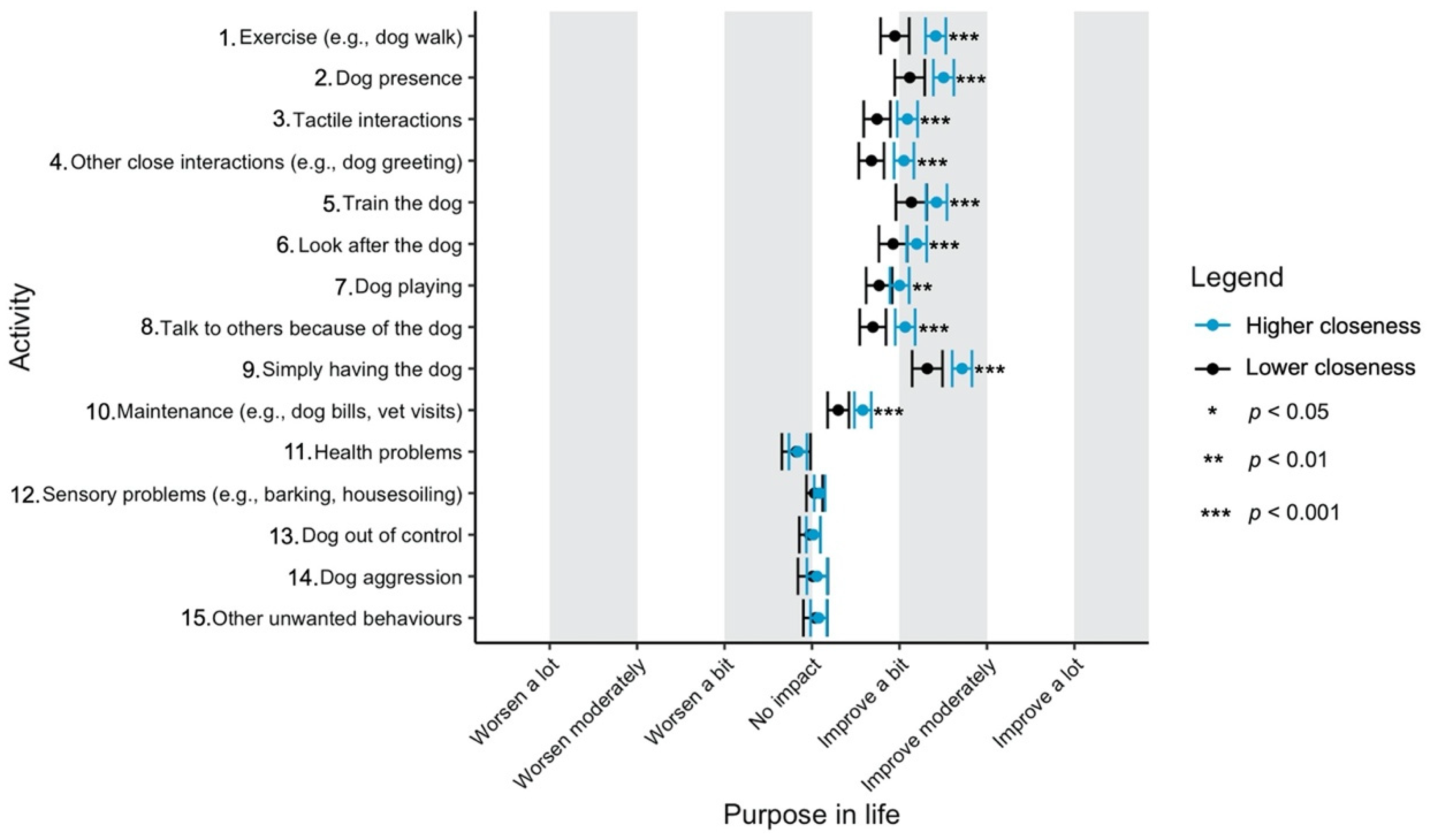
3.4.11. Self-Acceptance
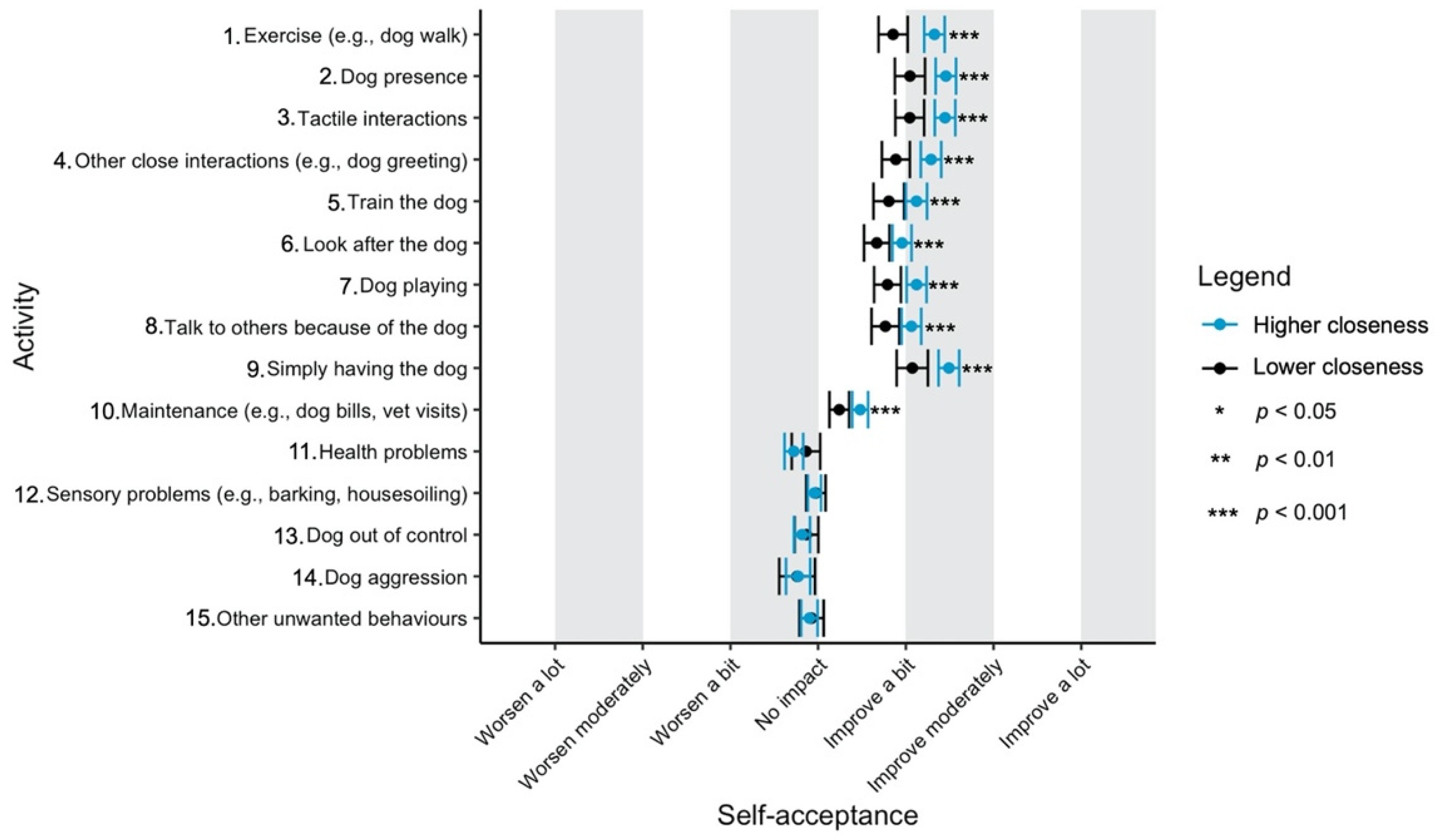
4. Discussion
4.1. Closeness to the Dog
4.2. Hedonic Well-Being and Life Satisfaction
4.3. Eudaimonic Well-Being
4.4. Strengths and Limitations
5. Conclusions
Supplementary Materials
Author Contributions
Funding
Institutional Review Board Statement
Informed Consent Statement
Data Availability Statement
Acknowledgments
Conflicts of Interest
References
- Jacobson, K.C.; Chang, L. Associations Between Pet Ownership and Attitudes Toward Pets With Youth Socioemotional Outcomes. Front. Psychol. 2018, 9, 2304. [Google Scholar] [CrossRef]
- Herzog, H. The Impact of Pets on Human Health and Psychological Well-Being. Curr. Dir. Psychol. Sci. 2011, 20, 236–239. [Google Scholar] [CrossRef]
- Islam, A.; Towell, T. Cat and dog companionship and well-being: A systematic review. Int. J. Appl. Psychol. 2013, 3, 149–155. [Google Scholar] [CrossRef]
- Gee, N.R.; Mueller, M.K. A Systematic Review of Research on Pet Ownership and Animal Interactions among Older Adults. Anthrozoös 2019, 32, 183–207. [Google Scholar] [CrossRef] [Green Version]
- Brooks, H.L.; Rushton, K.; Lovell, K.; Bee, P.; Walker, L.; Grant, L.; Rogers, A. The power of support from companion animals for people living with mental health problems: A systematic review and narrative synthesis of the evidence. BMC Psychiatry 2018, 18, 31. [Google Scholar] [CrossRef] [PubMed] [Green Version]
- McNicholas, J.; Gilbey, A.; Rennie, A.; Ahmedzai, S.; Dono, J.-A.; Ormerod, E. Pet ownership and human health: A brief review of evidence and issues. BMJ 2005, 331, 1252–1254. [Google Scholar] [CrossRef] [Green Version]
- Gee, N.R.; Rodriguez, K.E.; Fine, A.H.; Trammell, J.P. Dogs Supporting Human Health and Well-Being: A Biopsychosocial Approach. Front. Veter–Sci. 2021, 8, 630465. [Google Scholar] [CrossRef]
- Bennett, P.C.; Trigg, J.L.; Godber, T.; Brown, C. An Experience Sampling Approach to Investigating Associations between Pet Presence and Indicators of Psychological Wellbeing and Mood in Older Australians. Anthrozoös 2015, 28, 403–420. [Google Scholar] [CrossRef]
- Carr, D.; Friedmann, E.; Gee, N.; Gilchrist, C.; Sachs-Ericsson, N.; Koodaly, L. Dog Walking and the Social Impact of the COVID-19 Pandemic on Loneliness in Older Adults. Animal 2021, 11, 1852. [Google Scholar] [CrossRef]
- Cui, Y.; Russell, M.; Davern, M.; Christian, H. Longitudinal evidence of the impact of dog ownership and dog walking on mental health. J. Public Health 2021, 43, e145–e152. [Google Scholar] [CrossRef]
- Janssens, M.; Eshuis, J.; Peeters, S.; Lataster, J.; Reijnders, J.; Enders-Slegers, M.-J.; Jacobs, N. The Pet-Effect in Daily Life: An Experience Sampling Study on Emotional Wellbeing in Pet Owners. Anthrozoös 2020, 33, 579–588. [Google Scholar] [CrossRef]
- Pereira, J.M.; Fonte, D. Pets enhance antidepressant pharmacotherapy effects in patients with treatment resistant major depressive disorder. J. Psychiatr. Res. 2018, 104, 108–113. [Google Scholar] [CrossRef] [PubMed]
- Ng, M.; Wenden, E.; Lester, L.; Westgarth, C.; Christian, H. A study protocol for a randomised controlled trial to evaluate the effectiveness of a dog-facilitated physical activity minimal intervention on young children’s physical activity, health and development: The PLAYCE PAWS trial. BMC Public Health 2021, 21, 51. [Google Scholar] [CrossRef] [PubMed]
- Aydin, N.; Krueger, J.I.; Fischer, J.; Hahn, D.; Kastenmüller, A.; Frey, D.; Fischer, P. “Man’s best friend:” How the presence of a dog reduces mental distress after social exclusion. J. Exp. Soc. Psychol. 2012, 48, 446–449. [Google Scholar] [CrossRef]
- Vormbrock, J.K.; Grossberg, J.M. Cardiovascular effects of human-pet dog interactions. J. Behav. Med. 1988, 11, 509–517. [Google Scholar] [CrossRef]
- Allen, K. Cardiovascular reactivity and the presence of pets, friends, and spouses: The truth about cats and dogs. Psychosom. Med. 2002, 64, 727–739. [Google Scholar] [CrossRef] [Green Version]
- Petersson, M.; Uvnäs-Moberg, K.; Nilsson, A.; Gustafson, L.-L.; Hydbring-Sandberg, E.; Handlin, L. Oxytocin and cortisol levels in dog owners and their dogs are associated with behavioral patterns: An exploratory study. Front. Psychol. 2017, 8, 1796. [Google Scholar] [CrossRef] [Green Version]
- Barcelos, A.M.; Kargas, N.; Maltby, J.; Hall, S.; Mills, D.S. A framework for understanding how activities associated with dog ownership relate to human well-being. Sci. Rep. 2020, 10, 11363. [Google Scholar] [CrossRef] [PubMed]
- Deci, E.L.; Ryan, R.M. Hedonia, eudaimonia, and well-being: An introduction. J. Happiness Stud. 2008, 9, 1–11. [Google Scholar] [CrossRef]
- Joshanloo, M. Investigating the relationships between subjective well-being and psychological well-being over two decades. Emotion 2019, 19, 183–187. [Google Scholar] [CrossRef]
- Diener, E. Subjective well-being: The science of happiness and a proposal for a national index. Am. Psychol. 2000, 55, 34–43. [Google Scholar] [CrossRef]
- Ryff, C.D. Happiness is everything, or is it? Explorations on the meaning of psychological well-being. J. Pers. Soc. Psychol. 1989, 57, 1069–1081. [Google Scholar] [CrossRef]
- Ryff, C.D. Psychological Well-Being Revisited: Advances in the science and practice of Eudaimonia. Psychother. Psychosom. 2014, 83, 10–28. [Google Scholar] [CrossRef] [Green Version]
- Corrêa, G.F.; Barcelos, A.M.; Mills, D.S. Dog-related activities and human well-being in Brazilian dog owners: A framework and cross-cultural comparison with a British study. Sci. Prog. 2021, in press. [Google Scholar]
- Barcelos, A.M.; Kargas, N.; Packham, C.; Mills, D.S. Understanding the impact of dog ownership on autistic adults: Implications for mental health and suicide prevention. Sci. Rep. 2021, in press. [Google Scholar]
- Ravenscroft, S.J.; Barcelos, A.M.; Mills, D.S. Cat-human related activities associated with human well-being. Hum. Anim. Interact. Bull. 2021, in press. [Google Scholar]
- Huta, V. An overview of hedonic and eudaimonic well-being concepts. In Handbook of Media Use and Well-Being; Reinecke, L., Oliver, M.B., Eds.; Routledge: New York, NY, USA, 2016; pp. 32–51. [Google Scholar]
- Cavanaugh, L.A.; Leonard, H.A.; Scammon, D.L. A tail of two personalities: How canine companions shape relationships and well-being. J. Bus. Res. 2008, 61, 469–479. [Google Scholar] [CrossRef]
- Kanat-Maymon, Y.; Wolfson, S.; Cohen, R.; Roth, G. The benefits of giving as well as receiving need support in human–pet relations. J. Happiness Stud. 2021, 22, 1441–1457. [Google Scholar] [CrossRef]
- Queirós, A.; Faria, D.; Almeida, F. Strengths and limitations of qualitative and quantitative research methods. Eur. J. Educ. Stud. 2017, 3, 369–387. [Google Scholar]
- Scherer, K.R. What are emotions? And how can they be measured? Soc. Sci. Inf. 2005, 44, 695–729. [Google Scholar] [CrossRef]
- Yik, M.; Russell, J.A.; Steiger, J.H. A 12-point circumplex structure of core affect. Emotion 2011, 11, 705–731. [Google Scholar] [CrossRef] [Green Version]
- Russell, J.A. Core affect and the psychological construction of emotion. Psychol. Rev. 2003, 110, 145–172. [Google Scholar] [CrossRef] [PubMed]
- Aron, A.; Aron, E.N.; Smollan, D. Inclusion of Other in the Self Scale and the structure of interpersonal closeness. J. Pers. Soc. Psychol. 1992, 63, 596–612. [Google Scholar] [CrossRef]
- Gulick, E.E.; Krause-Parello, C.A. Factors related to type of companion pet owned by older women. J. Psychosoc. Nurs. Ment. Heal. Serv. 2012, 50, 30–37. [Google Scholar] [CrossRef]
- Christian, H.; Wood, L.; Nathan, A.; Kawachi, I.; Houghton, S.; Martin, K.; McCune, S. The association between dog walking, physical activity and owner’s perceptions of safety: Cross-sectional evidence from the US and Australia. BMC Public Health 2016, 16, 1010. [Google Scholar] [CrossRef] [PubMed] [Green Version]
- Lai, L.C.H.; Cummins, R.A.; Lau, A.L.D. Cross-cultural difference in subjective wellbeing: Cultural response bias as an explanation. Soc. Indic. Res. 2013, 114, 607–619. [Google Scholar] [CrossRef]
- Himsworth, C.G.; Rock, M. Pet ownership, other domestic relationships, and satisfaction with life among seniors: Results from a Canadian national survey. Anthrozoös 2013, 26, 295–305. [Google Scholar] [CrossRef]
- Eaves, L.C.; Ho, H.H. Young adult outcome of autism spectrum disorders. J. Autism Dev. Disord. 2008, 38, 739–747. [Google Scholar] [CrossRef] [PubMed]
- Simpson, P.L.; Schumaker, J.F.; Dorahy, M.J.; Shrestha, S.N. Depression and life satisfaction in Nepal and Australia. J. Soc. Psychol. 1996, 136, 783–790. [Google Scholar] [CrossRef] [PubMed]
- Westgarth, C.; Christley, R.M.; Marvin, G.; Perkins, E. I walk my dog because it makes me happy: A qualitative study to under-stand why dogs motivate walking and improved health. Int. J. Environ. Res. 2017, 14, 936. [Google Scholar] [CrossRef] [Green Version]
- Van Herwijnen, I.R.; Van Der Borg, J.A.M.; Naguib, M.; Beerda, B. Dog ownership satisfaction determinants in the owner-dog relationship and the dog’s behaviour. PLoS ONE 2018, 13, e0204592. [Google Scholar] [CrossRef] [Green Version]
- Handlin, L.; Hydbring-Sandberg, E.; Nilsson, A.; Ejdebäck, M.; Jansson, A.; Uvnäs-Moberg, K. Short-term tnteraction between dogs and their owners: Effects on oxytocin, cortisol, insulin and heart rate—an exploratory study. Anthrozoös 2011, 24, 301–315. [Google Scholar] [CrossRef]
- Odendaal, J.; Meintjes, R. Neurophysiological correlates of affiliative behaviour between humans and dogs. Vet. J. 2003, 165, 296–301. [Google Scholar] [CrossRef]
- Beetz, A.; Julius, H.; Turner, D.; Kotrschal, K. Effects of social support by a dog on stress modulation in male children with insecure attachment. Front. Psychol. 2012, 3, 352. [Google Scholar] [CrossRef] [Green Version]
- Horowitz, A.; Hecht, J. Examining dog–human play: The characteristics, affect, and vocalizations of a unique interspecific interaction. Anim. Cogn. 2016, 19, 779–788. [Google Scholar] [CrossRef] [PubMed]
- Swall, A.; Ebbeskog, B.; Hagelin, C.L.; Fagerberg, I. Can therapy dogs evoke awareness of one’s past and present life in persons with Alzheimer′s disease? Int. J. Older People Nurs. 2014, 10, 84–93. [Google Scholar] [CrossRef] [PubMed] [Green Version]
- Chandler, C.K.; Fernando, D.M.; Minton, C.A.B.; Portrie-Bethke, T.L. Eight domains of pet-owner wellness: Valuing the owner-pet relationship in the counseling process. J. Ment. Health Couns. 2015, 37, 268–282. [Google Scholar] [CrossRef]
- Ramírez, M.T.G.; Hernández, R.L. Benefits of dog ownership: Comparative study of equivalent samples. J. Vet. Behav. 2014, 9, 311–315. [Google Scholar] [CrossRef]
- Bao, K.J.; Schreer, G. Pets and happiness: Examining the association between pet ownership and wellbeing. Anthrozoös 2016, 29, 283–296. [Google Scholar] [CrossRef]
- Polheber, J.P.; Matchock, R.L. The presence of a dog attenuates cortisol and heart rate in the Trier Social Stress Test compared to human friends. J. Behav. Med. 2014, 37, 860–867. [Google Scholar] [CrossRef]
- Nettifee, J.A.; Munana, K.; Griffith, E.H. Evaluation of the impacts of epilepsy in dogs on their caregivers. J. Am. Anim. Hosp. Assoc. 2017, 53, 143–149. [Google Scholar] [CrossRef] [PubMed] [Green Version]
- Pergande, A.E.; Belshaw, Z.; Volk, H.A.; Packer, R.M.A. “We have a ticking time bomb”: A qualitative exploration of the impact of canine epilepsy on dog owners living in England. BMC Vet. Res. 2020, 16, 443. [Google Scholar] [CrossRef] [PubMed]
- Spitznagel, M.B.; Jacobson, D.M.; Cox, M.D.; Carlson, M.D. Caregiver burden in owners of a sick companion animal: A cross-sectional observational study. Vet. Rec. 2017, 181, 321. [Google Scholar] [CrossRef]
- Spitznagel, M.B.; Carlson, M.D. Caregiver burden and veterinary client well-Being. Vet. Clin. Small Anim. Pract. 2019, 49, 431–444. [Google Scholar] [CrossRef] [PubMed]
- Christiansen, S.B.; Kristensen, A.T.; Sandøe, P.; Lassen, J. Looking after chronically ill dogs: Impacts on the caregiver’s life. Anthrozoös 2013, 26, 519–533. [Google Scholar] [CrossRef]
- Buller, K.; Ballantyne, K.C. Living with and loving a pet with behavioral problems: Pet owners’ experiences. J. Vet. Behav. 2020, 37, 41–47. [Google Scholar] [CrossRef]
- Ben-Michael, J.; Korzilius, H.; Felling, A.; Vossen, J. An exploratory model of dog disciplining. Anthrozoös 2000, 13, 150–163. [Google Scholar] [CrossRef]
- Carr, E.C.J.; Wallace, J.E.; Onyewuchi, C.; Hellyer, P.W.; Kogan, L. Exploring the meaning and experience of chronic pain with people who live with a dog: A qualitative study. Anthrozoös 2018, 31, 551–565. [Google Scholar] [CrossRef]
- McNicholas, J.; Collis, G.M. Dogs as catalysts for social interactions: Robustness of the effect. Br. J. Psychol. 2000, 91, 61–70. [Google Scholar] [CrossRef]
- Kabel, A.; Khosla, N.; Teti, M. The Dog Narratives: Benefits of the human-animal bond for women with HIV. J. HIV/AIDS Soc. Serv. 2015, 14, 405–416. [Google Scholar] [CrossRef] [Green Version]
- Glaw, X.; Kable, A.; Hazelton, M.; Inder, K. Meaning in life and meaning of life in mental health care: An integrative literature review. Issues Ment. Health Nurs. 2016, 38, 243–252. [Google Scholar] [CrossRef] [PubMed]
- Love, H.A. Best friends come in all breeds: The role of pets in suicidality. Anthrozoös 2021, 34, 175–186. [Google Scholar] [CrossRef]
- Serpell, J.; McCune, S.; Gee, N.; Griffin, J.A. Current challenges to research on animal-assisted interventions. Appl. Dev. Sci. 2017, 21, 223–233. [Google Scholar] [CrossRef]
- Wells, D.L. The facilitation of social interactions by domestic dogs. Anthrozoös 2004, 17, 340–352. [Google Scholar] [CrossRef]
- Guéguen, N.; Ciccotti, S. Domestic dogs as facilitators in social interaction: An evaluation of helping and courtship behaviors. Anthrozoös 2008, 21, 339–349. [Google Scholar] [CrossRef]
- Flynn, E.; Combs, K.M.; Gandenberger, J.; Tedeschi, P.; Morris, K.N. Measuring the psychological impacts of prison-based Dog training programs and in-prison outcomes for inmates. Prison. J. 2020, 100, 224–239. [Google Scholar] [CrossRef]
- Leonardi, R.J.; Buchanan-Smith, H.M.; McIvor, G.; Vick, S.-J. “You think you’re helping them, but they’re helping you too”: Experiences of Scottish male young offenders participating in a dog training program. Int. J. Environ. Res. Public Health 2017, 14, 945. [Google Scholar] [CrossRef] [PubMed]
- Yount, R.; Ritchie, E.C.; Laurent, M.S.; Chumley, P.; Olmert, M.D. The role of service dog training in the treatment of combat-related PTSD. Psychiatr. Ann. 2013, 43, 292–295. [Google Scholar] [CrossRef] [Green Version]
- Cooke, B.J.; Farrington, D. The effects of dog-training programs: Experiences of incarcerated females. Women Crim. Justice 2015, 25, 201–214. [Google Scholar] [CrossRef]
- Antonio, M.E.; Davis, R.G.; Shutt, S.R. Dog training programs in Pennsylvania’s Department of Corrections. Soc. Anim. 2017, 25, 475–489. [Google Scholar] [CrossRef]
- Herzog, H. Women Dominate Research on the Human-Animal Bond. Available online: https://www.psychologytoday.com/us/blog/animals-and-us/202105/women-dominate-research-the-Human-animal-bond (accessed on 24 May 2021).
- Chia, D.; Powell, L.; Lee, V.; Haghighi, M.M.; Podberscek, A.; Ding, D.; Sherrington, C.; Stamatakis, E. Sociodemographic correlates of prospective dog owners’ intentions to participate in controlled trials of dog ownership and human health. BMC Res. Notes 2018, 11, 169. [Google Scholar] [CrossRef] [PubMed] [Green Version]
- Jenkins, R.; Bhugra, D.; Bebbington, P.; Brugha, T.; Farrell, M.; Coid, J.; Fryers, T.; Weich, S.; Singleton, N.; Meltzer, H. Debt, income and mental disorder in the general population. Psychol. Med. 2008, 38, 1485–1493. [Google Scholar] [CrossRef] [PubMed] [Green Version]
- Soto, C.J. Is Happiness Good for your personality? Concurrent and prospective relations of the Big Five with subjective well-being. J. Pers. 2014, 83, 45–55. [Google Scholar] [CrossRef] [PubMed]
- Utz, R.L. Walking the dog: The effect of pet ownership on human health and health behaviors. Soc. Indic. Res. 2013, 116, 327–339. [Google Scholar] [CrossRef]
- Mueller, M.K.; King, E.K.; Callina, K.; Dowling-Guyer, S.; McCobb, E. Demographic and contextual factors as moderators of the relationship between pet ownership and health. Health Psychol. Behav. Med. 2021, 9, 701–723. [Google Scholar] [CrossRef]
| 1. Exercise (e.g., walking, running, hiking with the dog, etc) | 6. Look after the dog (e.g., feeding, giving water) | 11. Health problems (dog health issues, e.g., injury, sickness) |
| 2. Dog presence (i.e., the presence/company of the dog) | 7. Dog playing (i.e., play with the dog or watch the dog play) | 12. Sensory problems (i.e., behavioural issues that disturb owner’s senses, e.g., dog barking, house soiling) |
| 3. Tactile interactions (i.e., touching or being touched by the dog) | 8. Talk to others because of the dog (e.g., say hello to others because of dog) | 13. Dog out of control (i.e., loss or lack of control over the dog, such as when the dog pulls on the lead, does not respond to recall) |
| 4. Other close interactions (e.g., dog greeting, talking to the dog) | 9. Simply having the dog (i.e., being a dog owner) | 14. Dog aggression (e.g., growling, trying to bite, biting) |
| 5. Train the dog (e.g., commands, housetraining) | 10. Maintenance (i.e., involvement in indirect tasks to provide for the dog, such bills, vet visits, purchases) | 15. Other unwanted behaviours (e.g., destruction of items, attention seeking, separation-related problems, etc) |
Publisher’s Note: MDPI stays neutral with regard to jurisdictional claims in published maps and institutional affiliations. |
© 2021 by the authors. Licensee MDPI, Basel, Switzerland. This article is an open access article distributed under the terms and conditions of the Creative Commons Attribution (CC BY) license (https://creativecommons.org/licenses/by/4.0/).
Share and Cite
Barcelos, A.M.; Kargas, N.; Maltby, J.; Hall, S.; Assheton, P.; Mills, D.S. Theoretical Foundations to the Impact of Dog-Related Activities on Human Hedonic Well-Being, Life Satisfaction and Eudaimonic Well-Being. Int. J. Environ. Res. Public Health 2021, 18, 12382. https://doi.org/10.3390/ijerph182312382
Barcelos AM, Kargas N, Maltby J, Hall S, Assheton P, Mills DS. Theoretical Foundations to the Impact of Dog-Related Activities on Human Hedonic Well-Being, Life Satisfaction and Eudaimonic Well-Being. International Journal of Environmental Research and Public Health. 2021; 18(23):12382. https://doi.org/10.3390/ijerph182312382
Chicago/Turabian StyleBarcelos, Ana Maria, Niko Kargas, John Maltby, Sophie Hall, Phil Assheton, and Daniel S. Mills. 2021. "Theoretical Foundations to the Impact of Dog-Related Activities on Human Hedonic Well-Being, Life Satisfaction and Eudaimonic Well-Being" International Journal of Environmental Research and Public Health 18, no. 23: 12382. https://doi.org/10.3390/ijerph182312382
APA StyleBarcelos, A. M., Kargas, N., Maltby, J., Hall, S., Assheton, P., & Mills, D. S. (2021). Theoretical Foundations to the Impact of Dog-Related Activities on Human Hedonic Well-Being, Life Satisfaction and Eudaimonic Well-Being. International Journal of Environmental Research and Public Health, 18(23), 12382. https://doi.org/10.3390/ijerph182312382







